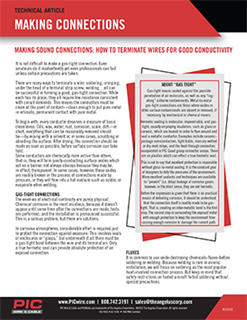Making Sound Cable Connections
HOW TO TERMINATE WIRES FOR GOOD CONDUCTIVITY
It is not difficult to make a gas-tight connection. Even amateurs do it inadvertently yet even professionals can fail unless certain precautions are taken.
There are many ways to terminate a wire: soldering; crimping; under the head of a terminal strip screw; or welding…all can be successful in forming a good, gas-tight connection. While each has its place, they all require low resistance consistent with circuit demands. This means the conductors must be clean at the point of contact—clean enough to put pure metal in intimate, permanent contact with pure metal.
To begin with, every conductor deserves a measure of basic cleanliness. Oils, wax, water, rust, corrosion, scale, dirt—in short, everything that can be reasonably removed should be—by wiping with a solvent or, in some cases, scrubbing or abrading the surface. After drying, the connection should be made as soon as possible, before surface corrosion can take hold.
Some conductors are chemically more active than others, that is, they will form poorly-conducting surface oxides which act as a barrier, not always obvious because they may be, in effect, transparent. In some cases, however, these oxides are readily broken in the process of connections made by pressure, or they will flow into a hot medium such as solder, or evaporate when welding.
GAS-TIGHT CONNECTIONS
The enemies of electrical continuity are purely physical. Chemical corrosion is the most insidious because it doesn’t appear until some time after the connections are made, tests are performed, and the installation is pronounced successful.
This is a serious problem, but there are solutions. In corrosive atmospheres, considerable effort is required just to protect the connection against exposure. This involves seals or enclosures or “goops,” but underneath it all there must be a gas-tight bond between the wire and its termination. Only a true hermetic seal can provide absolute protection of an exposed connection.
FLUXES
It is common to use oxide-destroying chemicals-fluxes before soldering or welding. Because welding is rare in avionic installation, we will focus on soldering as the most popular heat-involved connection process. But keep in mind that safety restrictions on fueled aircraft forbid soldering without special precautions.
Acid Fluxes
Among the great fluxes for metal cleaning before soldering is the dreaded acid flux (several types), which not only dissolves oxides but etches the metal. However, acid fluxes are suited only for mechanical (such as jewelry, sealed containers, copper plumbing, etc.) joinery, never electrical soldering. Eliminating every trace of flux residue is impractical, if not impossible, and even a few stray acid flux molecules can cause corrosion.
Rosin fluxes
Rosin fluxes become chemically active with heat and dissolve the oxides on tin, silver, and clean copper reasonably well. They are non-conductive at room temperature, but it is important to clean residual flux from the connection because moisture can combine with it to form a corrosive substance which could affect the connection over time.
FLUX-LESS SOLDERING
It should be added that no flux may be needed if the metals to be soldered are clean, perhaps freshly stripped, and tinned to begin with. Obviously, this eliminates flux removal concerns but such a process calls for careful evaluation and preparation, not to mention inspection after soldering. A classic no-flux soldering process is re-flow soldering, where sufficient clean solder is already applied to the surfaces to be
joined, which are then placed together. Heating causes the solder to flow. To make a gas-tight crimped connection, it is important to begin with clean wire and a properly-sized terminal or pin. Obviously, a terminal with too large an internal diameter will not form correctly around the wire, leaving excessive space to harbor contaminants, and could even fall off (insufficient deforming) or crack (excessive deforming). Too
small a terminal invites strand-cutting or some other form of butchery.
Every terminal is designed for a specific-size wire (or range of sizes) and has a recommended tool, die or tool setting for correct application. See Table 1. Truly consistent crimps are performed using only cycling-type tools—those that will not release the terminal until the crimping operation is complete.
| Terminal Size | Color Band | Wire AWG | Crimp Tool | Positioner |
|---|---|---|---|---|
| 22 | Green | 22-26 | M22520/2-01 | M22520/2-23 |
| 20 | Red | 20-24 | M22520/2-01 | M22520/2-03 |
| 16 | Blue | 16-20 | M22520/1-01 | M22520/1-02 |
| 12 | Yellow | 12-14 | M22520/1-01 | M22520/1-11 |
Even the lowly screw terminal (on a household light switch, for example) is capable of an excellent gas-tight connection. Assuming things are clean, the pressure and scuffing of the screw-head on bare wire penetrate surface oxides of both and make a good, low-resistance connection. This, of course, also applies to barrier-strip connections found in many electronic and power systems.
LOW-LOSS RF TERMINATIONS
Making a good coaxial cable termination may be “second nature” to those who do it every day, but some avionic technicians don’t have this luxury. So here are some tips you may find useful.
Almost all PIC coaxial connectors have the same “cut spec.” Basically, this means that regardless of the cable size or the connector type, there is uniformity as to where cuts are to be made. Keeps things simple.
Not so simple is dealing with tape-wrap low-loss dielectric (the insulation between the conductor and the shields). This stuff is soft, delicate, sometimes “stringy” and hard to remove. But this is the magic ingredient that yields superior electrical performance. Tape-wrap Teflon® has a way of conforming to the conductor— even to the point of getting buried in the tiny spaces (“interstices”) between adjacent strands of a stranded conductor. It may be hard to completely sever when you make the cut, and surely you don’t want to bear down on the blade just to get it all, only to create nicks in the conductor.
So you’ll pull off the slug—most of it—and then very carefully pick at the stringy leftovers. This may not be fun & games, but an important part of making the conductor ready for the pin.
The advantages of PIC’s weatherproofing on every connector will be realized only if potential leaks are eliminated. This is accomplished by trimming shield braid with care, one connector at a time.
If all this seems laborious, it is not. And we have thorough instructions provided with every connector. We also have a video—a “how to” run-through that shows every detail.

